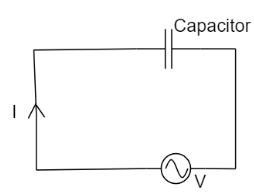
What is the frequency of power in the a.c circuit when connected to a capacitor? Given
A.
B.
C.
D. Zero
Answer
403.2k+ views
Hint: Total Power consumed in the circuit is the product of voltage of circuit and the current flowing in the circuit. In A.c circuit we can find the instantaneous power of circuit by multiplying the instantaneous voltage and current. Also the alternating current or alternating voltage has some frequency.
Formula used:
Where,
Complete step by step answer:
In an A.C circuit the instantaneous power of the circuit is calculated by multiplying instantaneous voltage and instantaneous current. This can be represented as:

Now we can calculated instantaneous voltage as:
Similarly instantaneous value of current can be calculated as:
But in a capacitor the current leads to its original value by a phase angle of
By using equation
We can write,
On rearranging the terms we get the result as:
On multiplying and dividing by two we get the result as:
We know that,
Therefore we can observe that magnitude of power will be equal to
Hence the correct option is B.
Note: It must be noted that
Formula used:
Where,
Complete step by step answer:
In an A.C circuit the instantaneous power of the circuit is calculated by multiplying instantaneous voltage and instantaneous current. This can be represented as:

Now we can calculated instantaneous voltage as:
Similarly instantaneous value of current can be calculated as:
But in a capacitor the current leads to its original value by a phase angle of
By using equation
We can write,
On rearranging the terms we get the result as:
On multiplying and dividing by two we get the result as:
We know that,
Therefore we can observe that magnitude of power will be equal to
Hence the correct option is B.
Note: It must be noted that
Recently Updated Pages
Master Class 9 General Knowledge: Engaging Questions & Answers for Success

Master Class 9 English: Engaging Questions & Answers for Success

Master Class 9 Science: Engaging Questions & Answers for Success

Master Class 9 Social Science: Engaging Questions & Answers for Success

Master Class 9 Maths: Engaging Questions & Answers for Success

Class 9 Question and Answer - Your Ultimate Solutions Guide

Trending doubts
Give 10 examples of unisexual and bisexual flowers

Draw a labelled sketch of the human eye class 12 physics CBSE

Differentiate between homogeneous and heterogeneous class 12 chemistry CBSE

Differentiate between insitu conservation and exsitu class 12 biology CBSE

What are the major means of transport Explain each class 12 social science CBSE

Why is the cell called the structural and functional class 12 biology CBSE




